Laura Castellanos’ buttons, available at the Seattle Art Museum‘s gift shop and online.

Regina Hackett takes her Art to Go
Laura Castellanos’ buttons, available at the Seattle Art Museum‘s gift shop and online.

Literature has a bad sex award. Despite stiff competition, this year Philip Roth walked away with it. If art offered something similar, Jeff Koons would be a shoe-in for lifetime achievement: From Made in Heaven from 1991.
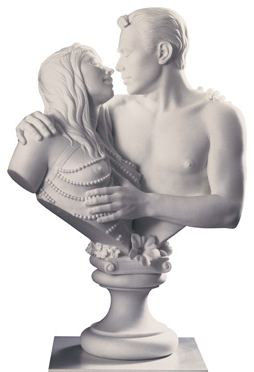 Lifetime achievement for best sex in an art context?
Lifetime achievement for best sex in an art context?
Wayne Miller,
from The Way of Life of the Northern Negro, Chicago (embrace), 1946-48. Sixty-plus years later, nobody has topped it.
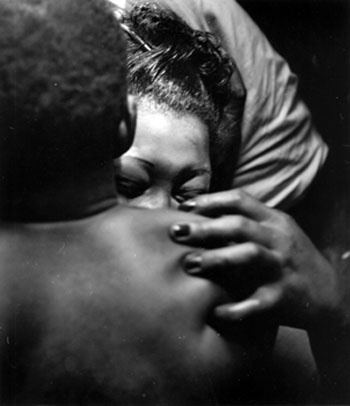
Thanksgiving is an excellent time to remember the real story, buried under fiction. Miles Standish and his anger management problem cannot taint the efforts of individual Americans to do better. (See Howard Zinn’s A People’s History of the United States.)
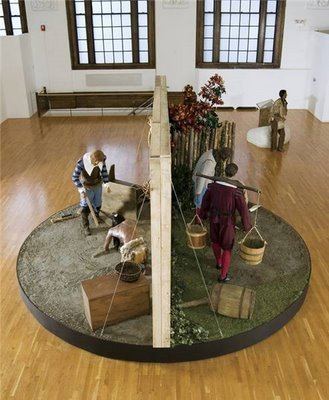
Discovered by happy accident in a lab at Oregon State:
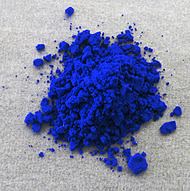 Online, it looks a lot like Yves Klein blue, but it’s safe and (when generics appear) cheap.
Online, it looks a lot like Yves Klein blue, but it’s safe and (when generics appear) cheap.
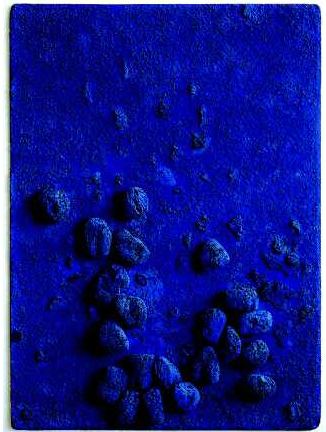 Glasstire’s Top Ten art activists.
Glasstire’s Top Ten art activists.
The boom in Doomsday.
At monasteries on Mount Athos in northern Greece, you wake in the night to the sound of Greek Orthodox monks chanting Byzantine prayers. It’s an unforgettable sound, distant and unearthly, but also inside you, like a buzz in the blood.
The painter Domenikos Theotokopoulos, better known as El Greco, almost certainly heard it growing up far to the south on the island of Crete. You can hear it today when you visit “The Origins of El Greco: Icon Painting in Venetian Crete,” a lustrous exhibition at the Onassis Cultural Center in Midtown Manhattan. (more)
Former PI editor Gil Aegerter on the play, It’s Not In The PI, a response to my review:
Finally got a chance to see the play on the final day, and I must say I liked it — with reservations. I agree with Regina that if you weren’t on the inside, you might find it confusing and disjointed. But I thought it captured the quirky character of the P-I quite well (kind of like the Adcock review that’s quoted). And it works as metafiction — the play as newspaper story, reported and written well or poorly, depending on your viewpoint, whether you were skewered. I would like to see the play refined and leaned-out, because there are some fantastic moments. The reporter-politician exchanges were just perfect. The Green River segment was poignant. The comment by the victim’s mom who is grateful to the reporter for not describing her daughter by job or crime — it’s the same care that this play shows to the P-I.
The same care this play shows to the PI? Aegerter is fluent in quadratic equations, reads classical philosophy for fun and could front a band good enough to hit the road. As a theater critic, however, he comes up empty.
Note to Gil: You worked there for years. Did you inhabit your own experience?
If the PI resembled the paper dissected on stage, Aegerter wouldn’t have worked there for a day. Former PI reporter Tom Paulson, who advised the playwright team, told them not to turn reporters into heroes. There’s a lot of ground between hero and nonentity, and this play didn’t find it. Nothing on stage mattered. Yes, Gil, the reporter-politician exchanges were good, but they concerned some harried public official having an affair. Since this is the only moment that explores a reporter doing the real job, why was the theme chosen so trivial?
I’ll agree that the play (more or less) attempted to capture the paper’s quirky character but cut that quality free from its roots, the business of providing the public with news and opinion of consequence. Trivial stories appeared in the PI. Of course they did. Breath and depth gave way to quick and dirty. But every day there was something and usually several somethings I was proud of, something enterprising, hard won and well played.
The PI was unusual in one respect: Despite cutbacks, the addition of good
management at the top coupled with a tipping-point infusion of fine reporters woke the place up in its final years. I know they woke
me up. Thanks to them, we did not fade away but went down strong.
It’s Not In the The PI wasn’t written as an elegy for the PI. What its fact-based fiction tried and failed to be is an elegy for a newsroom. Not a single character interested me, save for the brief (and entirely accurate) appearance of theater critic Joe Adcock. If these characters were a newsroom, it would be one that deserved its demise. Its occupants are self-indulgent, dim-witted whiners. What could they write (draw, photograph, design or edit) that could possibly interest anyone?
The best elegy for newsroom culture arrived this year in the form of a thriller: Michael Connelly’s The Scarecrow. The paper is the LA Times, which is diminished but not yet dead, despite the efforts of its owner to kill it. Connelly doesn’t get into that, wisely. He has a monster killer to deal with and doesn’t need Sam Zell, the monster Capitalist, cluttering up his copy.
The Scarecrow does not address why we’re losing breath and depth, just that we are, in Matthew Arnold’s phrase, “wandering between worlds, one dead, the other powerless to be born.” In the meantime, there’s a great newsroom fallen on hard times. We meet the narrator, reporter Jack McEvoy, just after he’d been laid off.
Every eye in the newsroom followed me as I left Kramer’s office and walked back to my pod. The long looks made it a long walk. The pink slips always came out on Fridays and they all knew I had just gotten the word.
From a newsroom friend:
Holy fucking shit, you got pinked!…Man, this ain’t right.
The world ain’t right, Larry.
Like the paper itself, my time was over. It was all about the Internet now. It was about hourly uploads to online editions and blogs. It was about television tie-ins and Twitter updates…The morning paper might as well be called the Daily Afterthought. Everything in it was posted on the web the night before.
Editor and McEvoy exchange:
[Read more…] about It’s Not In The PI, but it is in “The Scarecrow”
Sloth’s best. Lolling on a sofa
In a Chinese dressing gown
With the windows open in the heat,
The breeze rousing the leaves.
The flies dozing on the ceiling.
The silky hush of a summer afternoon,
Like floating on one’s back
With eyes closed in some pond
Clogged with water lilies,
Inhaling their scent as they nuzzle close.
The light and shade dillydallying,
The leaves sighing again.
Afterward, not even that.
Majestic stupor. Stirring only at midnight
To click on the yellow table lamp.
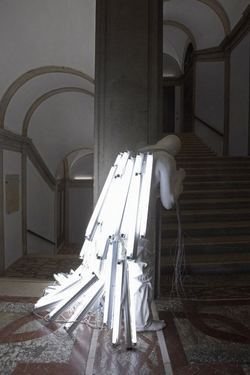 Charles Simic, The Secret Of The Yellow Room
Charles Simic, The Secret Of The Yellow Room
Images: 1. Geoffrey Chadsey. 2. Fred Muram 3. Glenn Rudolph 4. Chadsey 5. Eric Elliott 6. Bernardi Roig
From Jennifer Zwick, image via
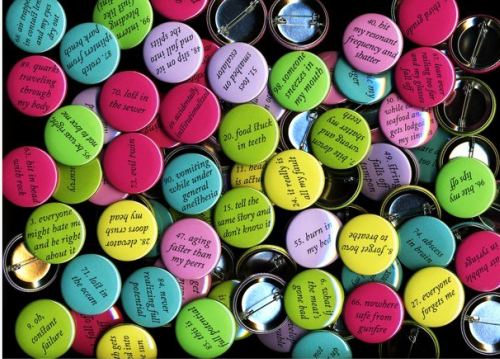 Previous in the same vein, Zwick’s 100 Answers To What Might Go Wrong.
Previous in the same vein, Zwick’s 100 Answers To What Might Go Wrong.
an ArtsJournal blog


